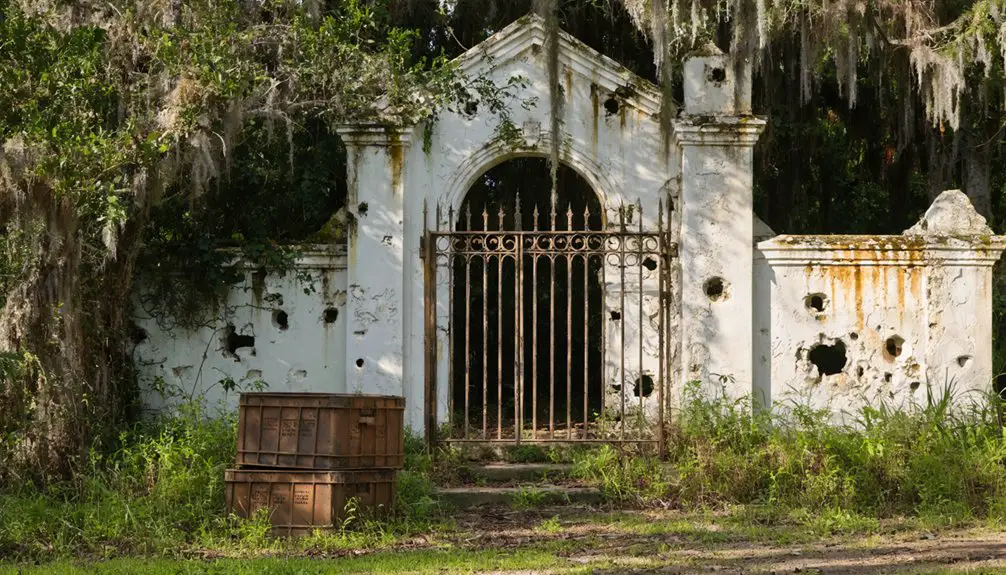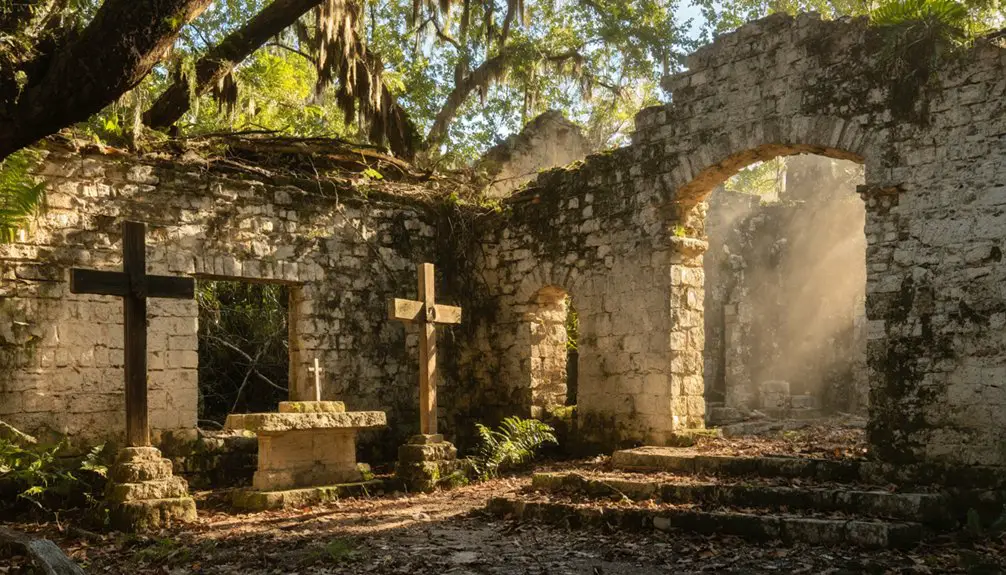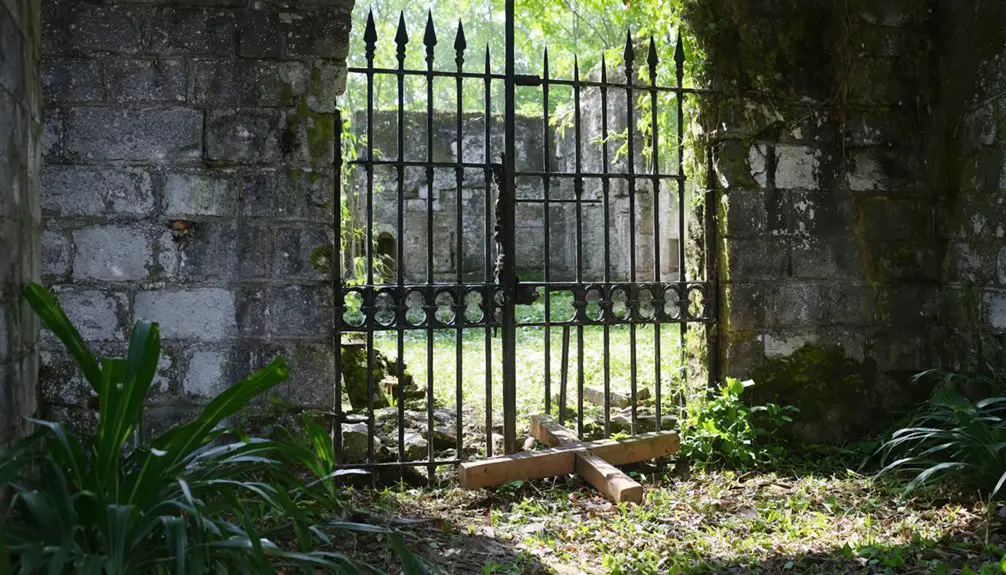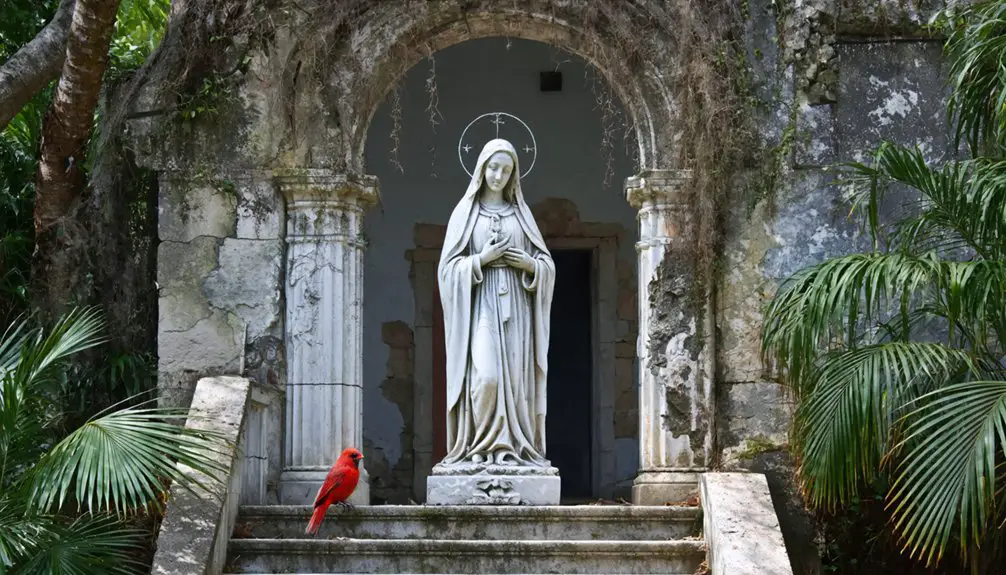You’ll discover the haunting ruins of Saint Anne’s Shrine nestled in Florida’s wilderness, a former French Canadian Catholic settlement established in 1920 by Napoleon Pelletier. The 15-acre sacred lake once drew thousands seeking miraculous healing, with a 40-foot stone grotto modeled after France’s Lourdes. Though abandoned since the 1960s, the site’s weathered altar, stone baptistry, and original pathways still whisper stories of profound spiritual pilgrimages and reported miracle cures.
Key Takeaways
- Saint Anne’s Shrine began as a French Canadian Catholic settlement in 1920 and became abandoned in the 1960s, creating a ghost town.
- The site features ruins of a stone grotto, chapel foundations, and healing sanctuary modeled after France’s Lourdes shrine.
- After founder Napoleon Pelletier’s death in 1942 and World War II’s impact on pilgrimages, the community declined dramatically.
- The 15-acre property contains weathered stone structures, including a 40-foot grotto and stone bridge amid Florida wilderness.
- Local residents prevented commercial development in the 1980s, preserving the ruins as a spiritual site open for prayer.
The French Canadian Origins
When French Canadian Catholics sought refuge from harsh northern winters in 1920, they established Saint Anne’s Shrine in rural Florida under the leadership of Napoleon Pelletier.
This immigrant community crafted their spiritual home in the image of cherished sites from their homeland, particularly St. Anne de Beaupre in Quebec. As the shrine’s informal leader, Pelletier guided both construction efforts and community organization, ensuring their cultural traditions would flourish in their new southern setting. A stunning 40-foot-high grotto made of native Florida stone became the centerpiece of the shrine.
Following Pelletier’s death, his remains were temporarily interred at the shrine before being transported back to Canada, though his grave marker still stands near the grotto today. The shrine soon gained recognition, hosting two annual pilgrimages that drew thousands of faithful visitors.
The shrine’s dedication to St. Anne reflected the deep French Canadian devotion to the grandmother of Jesus, who they revered as the patron saint of sailors.
A Sacred Lake’s Promise of Healing
You’ll find St. Anne’s lake at the heart of reported healing miracles that began drawing pilgrims in the 1920s, including Francis Marsollier’s son who recovered from tuberculosis after prayers at the site.
The shrine’s French Canadian founders created a healing sanctuary modeled after Lourdes, France, complete with a 40-foot stone grotto and enclosed spring well for collecting the lake’s purported curative waters. Today, the site is carefully maintained by local residents who preserve its sacred character. The shrine’s dedication to Saint Anne remains evident through its annual Easter Mass.
The promise of both physical and spiritual restoration brought thousands to this Florida site during its peak years, establishing it as a significant pilgrimage destination that blended Catholic healing traditions with the natural setting.
Miracle Waters Draw Pilgrims
At the heart of Saint Anne’s Shrine lay a 15-acre lake whose waters drew thousands of pilgrims seeking miraculous healing in the 1920s and ’30s.
You’d find devotees gathered at the 40-foot grotto, modeled after Lourdes, where at least one notable healing was documented. The lake’s reputation for spiritual experiences began when either Pelletier’s son or Francis Marsollier’s son recovered from tuberculosis after contact with its waters.
Two annual pilgrimages marked the calendar – February honoring Our Lady of Lourdes and July celebrating Saint Anne’s feast day.
You could join fellow seekers in prayer at the outdoor altar or walk the wooded Stations of the Cross. The shrine’s French Canadian founders created this sacred space where faith and hope merged at the water’s edge.
French Canadian Faith Legacy
The French Canadian origins of Saint Anne’s Shrine traced back to Napoleon Pelletier and his fellow settlers who sought refuge from harsh northern winters in the 1920s.
Drawing inspiration from St. Anne de Beaupre in Canada, they established a sacred space where faith expressions flourished through art, relics, and cultural rituals.
You’ll find their spiritual legacy preserved in Francis Marsollier’s murals and sculptures, created after his son’s miraculous recovery from tuberculosis.
The shrine’s collection of sacred relics, including fragments of the True Cross and Saint Anne’s own remains, deepened the devotional practices of visiting pilgrims.
Twice-yearly celebrations in February and July drew thousands to honor Our Lady of Lourdes and the Feast of St. Anne, marking the shrine’s significance as a cultural anchor for Florida’s French Canadian community.
The site’s historical connection to faith and community endured until the nearby Black Hills Passion Play brought new religious performances to the area from 1953 to 1998.
Napoleon Pelletier’s Vision
During the early 1920s, Napoleon Pelletier led a group of French Canadian Catholics to establish Saint Anne’s Shrine near Lake Wales, Florida, driven by his vision to create a spiritual sanctuary modeled after the healing sites of Lourdes, France and Saint-Anne-de-Beaupre, Canada.
Pelletier’s aspirations materialized through the construction of a white chapel, a replica of the Lourdes grotto, and various religious monuments. A tin can manufacturer from Queens, New York, Pelletier invested his business success into developing the shrine.
You’ll find that his dedication transformed the remote location into a renowned pilgrimage destination, where thousands sought spiritual restoration before World War II.
He established formal pilgrimages in 1928, with celebrations in February for Our Lady of Lourdes and July for the Feast of St. Anne.
The shrine’s spring, later walled into a well, became central to healing rituals that drew faithful visitors seeking miraculous cures.
Architecture and Sacred Structures
You’ll find the shrine’s most distinctive feature in its stone construction, which stood apart from Florida’s typical architectural materials of the 1920s.
The white chapel’s sacred design incorporated ritual spaces for healing and devotion, anchored by French artist Francis Marsollier’s religious artwork.
While most structures have been lost to time, you can still explore the surviving Lourdes Grotto replica, which remains the site’s primary architectural representation of its spiritual legacy.
Distinctive Florida Stone Design
Standing 40 feet high, Saint Anne’s Shrine‘s remarkable grotto showcased native Florida stone architecture that merged European religious influences with local materials. The handcrafted stonework exemplified sacred symbolism through its replication of France’s Lourdes grotto, while demonstrating local architectural craftsmanship in its rustic yet sturdy construction.
You’ll discover these distinctive design elements throughout the shrine:
- A stone bridge spanning a protective moat, integrating functional design with spiritual significance
- Weather-resistant native stone that’s endured since the shrine’s 1960s abandonment
- Thoughtfully arranged stone and old-fashioned concrete creating seamless sacred spaces
- Natural stone formations blending with handmade structures to form an organic pilgrimage setting
The shrine’s design successfully united Canadian Catholic heritage with Florida’s landscape through durable materials and meaningful architectural elements. The handmade tile work adds intricate detail to the shrine’s rustic stone features.
Chapel’s Sacred Floor Elements
While Saint Anne’s chapel is now largely in ruins, its sacred floor elements once embodied both practical function and spiritual symbolism through carefully selected materials and design.
The traditional tile flooring, common to early 20th-century Florida religious architecture, featured sacred symbolism in its patterns, with motifs likely including crosses, fish, and Marian symbols honoring Saint Anne. French Canadian Catholics established the chapel in the early 1920s as a winter retreat destination.
You’ll find the floor plan followed classic Catholic chapel layouts, with a central nave flanked by side aisles and a prominent processional path to the altar.
Though weathered by decades of abandonment since the 1960s, remaining floor fragments still hint at the careful integration of locally sourced materials that once withstood Florida’s humidity while guiding worshippers through their sacred rituals and pilgrimages.
Grotto and Altar Remnants
Nestled within an oak hammock draped with Spanish moss, Saint Anne’s grotto stands as a remarkable 40-foot-high replica of France’s famous Grotto of Lourdes.
Built around 1920 using native Florida stone, you’ll find this sacred structure connected by a stone bridge crossing a meditative moat.
The grotto’s symbolism represents miraculous healing and spiritual restoration, while its weathered altar still bears witness to decades of devotional use.
Here’s what you’ll discover at the site:
- A tiled altar that’s aged naturally since the 1960s
- A stone baptistry near the altar space
- A fountain dedicated to Saint Therese
- A white cross standing opposite the grotto
Though many original elements have been lost, the altar’s significance endures as one of the few remaining structures that continue to host occasional Easter services.
The Golden Age of Pilgrimages
During its heyday in the 1920s and 1930s, Saint Anne’s Shrine attracted thousands of pilgrims through two major annual gatherings – the February celebration of Our Lady of Lourdes and the July Feast of St. Anne.
You’d find Franco-Canadian Catholics escaping harsh northern winters, joining local faithful in prayer and healing rituals at the shrine’s grotto and lake.
The pilgrimages held deep cultural significance, reinforcing religious traditions that connected Florida to Canada. As the shrine’s reputation for miraculous healings grew, published accounts drew more visitors seeking spiritual and physical restoration.
The surrounding community actively maintained the grounds and promoted these gatherings, fostering strong community bonding through shared religious festivals. The Diocese of St. Augustine‘s formal recognition as a mission further elevated the shrine’s prominence in regional Catholic life.
Wartime Changes and Decline

You’ll find that World War II dealt a devastating blow to Saint Anne’s Shrine when Canadian pilgrims stopped their Florida journeys due to wartime travel restrictions.
The shrine’s religious significance gradually faded through the 1950s and early 1960s, leading the Catholic Diocese of Orlando to eventually desanctify and demolish the original chapel.
While local residents successfully prevented commercial development of the site in the 1980s, the shrine’s physical deterioration continued as religious artifacts disappeared and adjacent buildings were converted to private residences.
Wartime Travel Restrictions Impact
World War II severely disrupted Saint Anne’s Shrine’s importance when wartime travel restrictions prevented Canadian pilgrims from making their customary winter journeys to the Florida site.
The wartime regulations drastically altered pilgrim behavior, leading to a significant economic impact on the shrine community. With cross-border movement limited and resources rationed, Canadian visitors – who formed the backbone of the shrine’s attendance – were forced to remain home. After the death of shrine founder Napoleon Pelleter in 1942, maintenance and spiritual leadership of the site suffered further setbacks. The vintage bridge still standing at the shrine serves as a reminder of its once-thriving past.
- Travel restrictions caused pilgrims to favor local religious sites over distant shrines
- Resource rationing curtailed tourism activities throughout the 1940s
- Declining attendance led to reduced economic support for the shrine community
- Limited mobility during wartime contributed to the shrine’s diminishing prominence and eventual decline
The restrictions’ lasting effects ultimately influenced the Diocese’s later decision to desanctify the site, marking a turning point in the shrine’s history.
Religious Interest Fades Away
As wartime travel restrictions continued to impact Saint Anne’s Shrine through the 1940s, religious interest steadily declined beyond mere temporary disruption.
You’ll find that pilgrimage traditions, once vibrant with Canadian visitors during winter months, gradually faded away even after the war ended. The shrine underwent a profound religious transformation as large-scale gatherings gave way to quieter, individual prayer sessions.
Community engagement diminished greatly when visiting pilgrims stopped coming, and local attendees couldn’t maintain the shrine’s previous spiritual importance.
The Catholic Diocese of Orlando ultimately deemed the site obsolete by the early 1960s, leading to its desanctification.
Where once stood an active place of worship, you’ll now discover only remnants – peripheral structures and relocated artifacts that hint at its former religious significance.
Commercial Development Versus Preservation
The onset of World War II dealt a severe blow to Saint Anne’s Shrine, marking the start of its physical decline and sparking debates between commercial interests and preservation efforts.
You’ll find that community values ultimately shaped the shrine’s fate, as local residents consistently opposed attempts to commercialize this sacred space.
- When commercial interests threatened to convert shrine land into private residences in the 1980s, neighbors successfully blocked the development.
- The Knights of Columbus demonstrated their commitment by building a permanent altar.
- The local community maintains the grounds and protects them from vandalism.
- The site remains open daily for prayer, preserving its original spiritual purpose.
Despite the diocese declaring the shrine obsolete in the 1960s, grassroots preservation efforts have guaranteed it continues serving as a place of reflection rather than succumbing to commercial development.
Remnants of Holy Ground

Standing atop native Florida rock formations, remnants of Saint Annes Shrine offer glimpses into its former spiritual grandeur through surviving structures and artifacts.
You’ll find the original chapel‘s front steps leading to empty air, while scattered stonework and a rock bridge hint at the site’s historical significance. The stone grotto area, fountain, and portions of altar foundations persist as evidence of its sacred past.
Though most of the ornate statues have been relocated to Lake Wales’ Holy Spirit Catholic Church, you can still discover original chapel floor tiles and native rock construction features.
While the grand statues found new homes at Holy Spirit Church, Saint Annes’ floors and native stonework endure as silent witnesses.
The Knights of Columbus‘ permanent altar now hosts annual Easter masses, while the preserved grounds continue serving as a place of quiet reflection, accessible from sunrise to sunset despite its ghostly atmosphere.
Modern Religious Gatherings
Despite its ghost town status, Saint Ann Shrine maintains a vibrant spiritual presence through regular liturgical services and annual celebrations. You’ll find daily Mass Monday through Friday at 11:30 am, fostering community engagement and spiritual renewal.
The Congregation of the Blessed Sacrament oversees these sacred gatherings, welcoming pilgrims seeking intercession and hope.
Key religious observances at the shrine include:
- The Saint Ann Triduum in late July featuring thematic presentations
- Easter Mass celebrated at the shrine’s altar
- Daily Masses that can be requested for special intentions
- The annual Saint Ann festival honoring America’s patron saint
The shrine’s blend of natural setting and religious heritage creates a unique pilgrimage experience where you can participate in both traditional and adapted modern gatherings.
Preservation Challenges and Efforts

Since its abandonment in the early 1960s, Saint Anne’s Shrine has faced mounting preservation challenges that threaten its historical and religious legacy.
The Catholic Diocese of Orlando‘s decision to desanctify and demolish the church structure left only foundation remnants, while most original statues were either relocated or lost.
You’ll find the site’s preservation obstacles stem from natural weathering, vegetation overgrowth, and Florida’s harsh climate affecting the rare stone construction.
Despite these challenges, community engagement has proven crucial in protecting the shrine’s remains.
When the Diocese attempted to sell the property in the 1980s, local opposition successfully prevented redevelopment.
While the site remains accessible daily from sunset to sundown, limited funding and lack of official historic designation continue to hamper formal preservation efforts.
Exploring the Abandoned Shrine Today
Today’s visitors to Saint Anne’s Shrine encounter a hauntingly beautiful tableau of ruins nestled in the Florida wilderness.
Ancient stones and sacred remnants rest silently among wild Florida growth, creating an ethereal sanctuary frozen in time.
You can explore these sacred grounds daily from sunrise to sunset, though you’ll need to respect its private property status. The site offers profound opportunities for pilgrimage memories and spiritual reflections among its weathered remains.
- Follow the original stone steps that once led to the church, now leading to an open sky
- Discover the native Florida stone constructions, including a grotto, rock bridge, and fountain
- Walk the wooded trails to find relocated Stations of the Cross statuary
- Visit the lakeside stone platform where Saint Anne’s statue still stands, overlooking the waters once sought for healing
The surrounding circular layout of the former community remains visible, offering glimpses into this unique French-Canadian settlement’s past.
Frequently Asked Questions
Are There Any Documented Cases of Miraculous Healings at the Shrine?
You’ll find miraculous testimonies in three Dominican record volumes, including accounts of a blind man gaining sight in the 1950s, though healing practices weren’t formally investigated by Church authorities.
What Specific Religious Artifacts and Statues Were Saved Before Demolition?
You’ll find St. Anne’s relics (Crown of Thorns thorn, True Nail reproduction), ornate statues including St. Anne de Beaupré replica, and Christ of Limpias monument were preserved for their religious significance at Holy Spirit Catholic Church.
Do Any Descendants of Napoleon Pelletier Still Visit the Shrine?
You won’t find documented evidence of Pelletier legacy visits to the shrine. While Napoleon Pelletier’s grave remains on-site, there’s no historical record confirming his family’s continued connection through visits.
What Paranormal Activities Have Been Reported at the Abandoned Shrine?
You’ll encounter ghost sightings of monks and pilgrims near the grotto, along with eerie sounds like phantom footsteps, disembodied prayers, and mysterious bells. Cold spots and unexplained touches are frequently reported.
How Many Pilgrims Visited the Shrine During Its Peak Years?
In the blink of an eye, you’d see thousands during peak pilgrimages, with shrine history showing several tens of thousands annually in the 1920s-30s. Pilgrim statistics peaked before WWII’s disruption.
References
- https://abandonedfl.com/st-anne-shrine/
- https://beyond.nvexpeditions.com/florida/stanne.php
- https://www.orlandoattractions.com/ghosts-and-mystery-in-polk-county/
- https://www.youtube.com/watch?v=4SNnCp47pHs
- http://www.badattitudebirding.com/index.php?pgaction=pages.fieldNotes&pID=0662DEAC-25BB-2AA1-9112F5CFCA5C40AD
- https://www.stpetersplantcity.com/st-anne-s-shrine
- https://en.wikipedia.org/wiki/Ste_Anne_des_Lacs
- https://www.stpetersplantcity.com/a-return-to-st-anne-s-shrine
- https://frontier-florida.blogspot.com/2019/12/secret-sanctuary-holy-place.html
- https://www.findagrave.com/memorial/7560759/napoleon-pelletier



